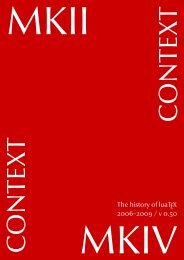Equal Font Metrics - Pragma ADE
Equal Font Metrics - Pragma ADE
Equal Font Metrics - Pragma ADE
You also want an ePaper? Increase the reach of your titles
YUMPU automatically turns print PDFs into web optimized ePapers that Google loves.
1<br />
The Palatino fonts that ship with TEX distributions originate at URW. The most<br />
direct way to generate the metrics that TEX feels comfortable with is to use AFM2TFM,<br />
but there are other means as well. The name of the file that contains the normal<br />
glyphs (pictures) is uplr8a.pfb, while the encoding specific metrics are defined in<br />
for instance uplr8t.tfm. However, there is also a file named pplr8t.tfm that serves<br />
the same encoding subset.<br />
At PRAGMA <strong>ADE</strong> we prefer to use the original metrics, if only because we cannot be<br />
sure what happens with derived ones. Taking the original metrics uplr8a.afm as<br />
starting point we can generate whatever encoding we like. The CONTEXT specific<br />
files are prefixed by the name of the encoding vector. Such metric files are generated<br />
by for instance TEXFONT. In this note we wil stick to pre-built metrics.<br />
When users want to use the Palatino metrics that come with distribution, they can<br />
choose between the u and p ones. The number of supported encodings is limited<br />
(for instance, the texnansi metrics are seldom distributed). You get the original<br />
URW metrics (prefixed by u) with:<br />
\usetypescript[berry][ec]<br />
The p variants (somehow related to Adobe) are chosen by:<br />
\usetypescript[adobekb][ec]<br />
Contrary of what some people may want you to believe, these metrics do differ!<br />
Some of the differences can be due to the fact that the number of heights and<br />
depths within a font is limited. However, since we deal with the same subset of<br />
glyphs, one does not expect this. In this document we will demonstrate this. We<br />
leave it up to the reader to decide how to act on this. In the example below, the<br />
left sample uses uplr8t.tfm, the right hand one pplr8t.tfm. Both samples use a<br />
quote by E.R. Tufte.<br />
We thrive in information--thick worlds because of<br />
our marvelous and everyday capacity to select,<br />
edit, single out, structure, highlight, group, pair,<br />
merge, harmonize, synthesize, focus, organize,<br />
condense, reduce, boil down, choose, categorize,<br />
catalog, classify, list, abstract, scan, look into, idealize,<br />
isolate, discriminate, distinguish, screen, pigeonhole,<br />
pick over, sort, integrate, blend, inspect,<br />
filter, lump, skip, smooth, chunk, average, approximate,<br />
cluster, aggregate, outline, summarize, itemize,<br />
review, dip into, flip through, browse, glance<br />
into, leaf through, skim, refine, enumerate, glean,<br />
synopsize, winnow the wheat from the chaff and<br />
separate the sheep from the goats.<br />
We thrive in information--thick worlds because of<br />
our marvelous and everyday capacity to select,<br />
edit, single out, structure, highlight, group, pair,<br />
merge, harmonize, synthesize, focus, organize,<br />
condense, reduce, boil down, choose, categorize,<br />
catalog, classify, list, abstract, scan, look into, idealize,<br />
isolate, discriminate, distinguish, screen, pigeonhole,<br />
pick over, sort, integrate, blend, inspect,<br />
filter, lump, skip, smooth, chunk, average, approximate,<br />
cluster, aggregate, outline, summarize,<br />
itemize, review, dip into, flip through, browse,<br />
glance into, leaf through, skim, refine, enumerate,<br />
glean, synopsize, winnow the wheat from the<br />
chaff and separate the sheep from the goats.
















